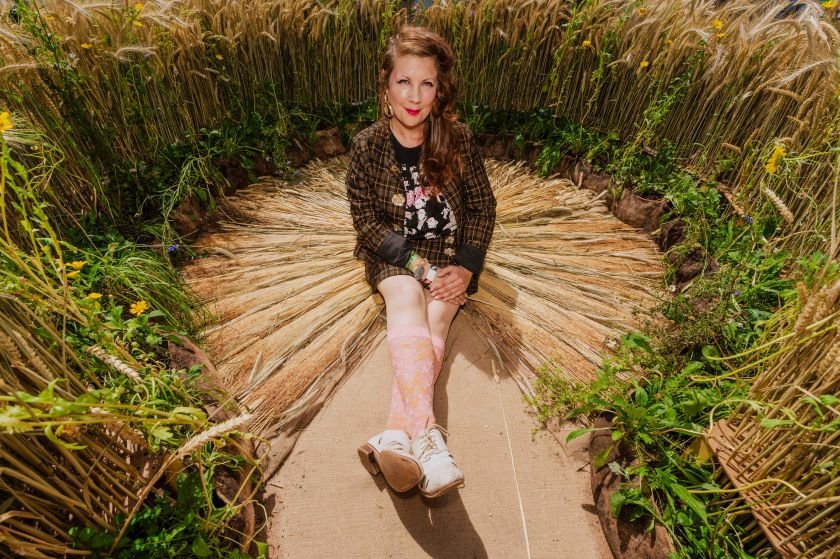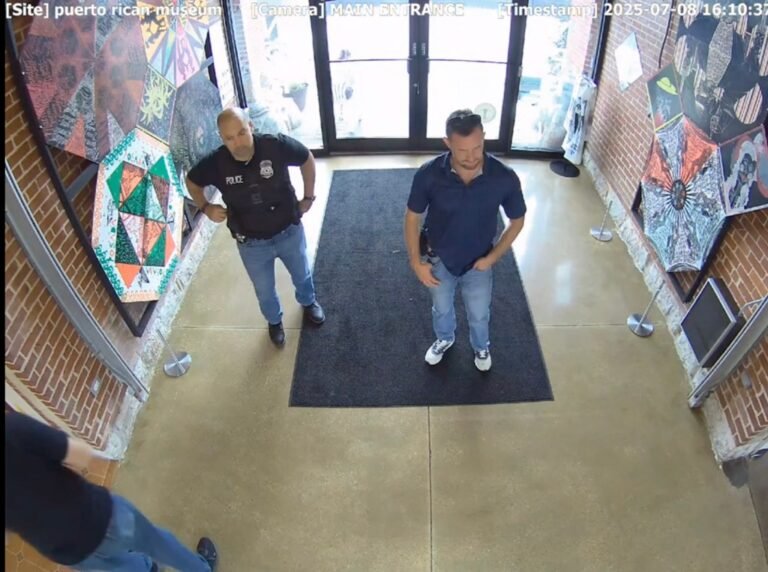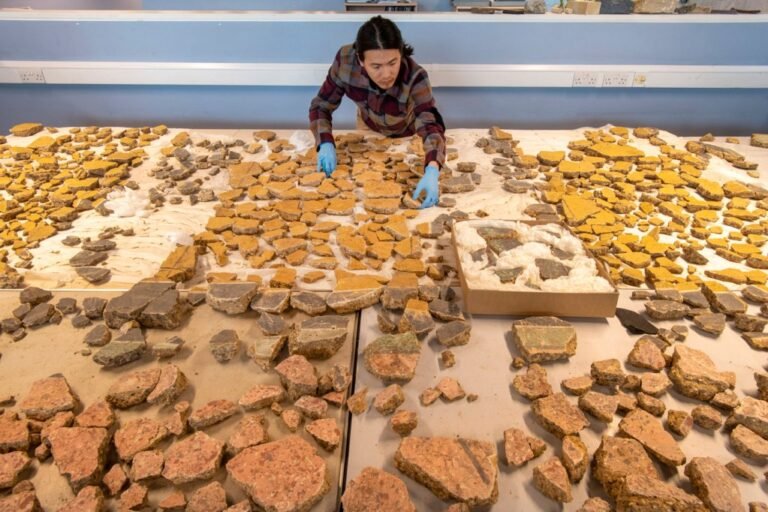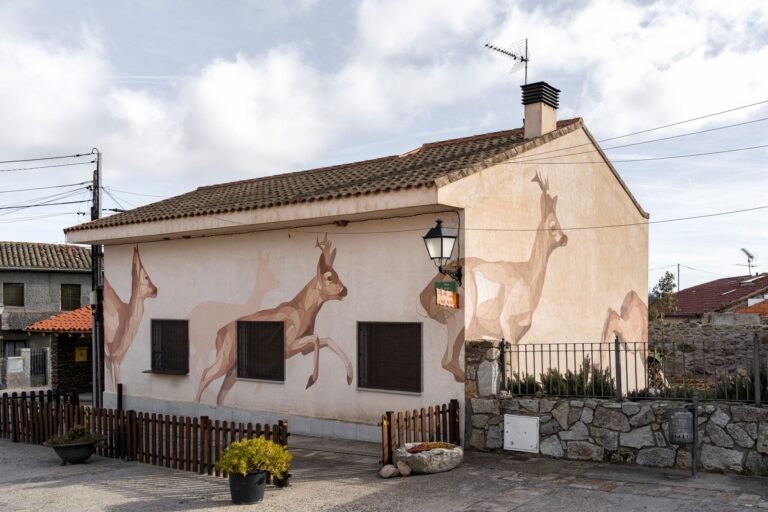

Kaye Dunnings. Photo: Leora Bermeister
Shangri-La 2025 began a new chapter in festival creativity. Meet the creative force behind it.
Last month, as a fifth of a million people streamed into Glastonbury’s sprawling Worthy Farm, the entrance to Shangri-La radiated with even more energy than usual. This year, as we reported live, the legendary field felt both familiar and radically new: a patchwork of fresh collectives, interactive art, and a palpable sense of inclusivity.
Standing at the centre of it all was creative director Kaye Dunnings; her vision, once again, pushing the boundaries of what a festival environment can be.
Shangri-La has always been Glastonbury’s wildest playground, but this year, the changes were dramatic. The field’s layout was reimagined to be even more open and welcoming, with themes of nature and growth evoked by a series of interactive art installations.
As Kaye reasons: “People come to Glastonbury for more than just the headliners. They want to be transported, challenged, welcomed—and for that, we have to keep evolving.”
But how does one person orchestrate this level of creative anarchy at scale? To understand the alchemy behind Shangri-La’s transformation, you have to start with Kaye herself.
Early years: surviving, seeking, and subverting
In an industry dominated by middle-class graduates, Kaye’s journey is anything but conventional. Born in the late 1970s and raised on an estate in Totton, near Southampton, her childhood was marked by adversity.
“My area was really violent, never really that safe,” she recalls with a grimace. No one in her family had been to university; most of the women had entered motherhood as teenagers. Kaye, though, felt she was destined for something different.
School was a battleground, where her creativity and unique sense of style made her a target for bullies. “I managed to cope through music,” she says. “The radio was my window onto the world. John Peel, my dad’s records… I realised there was more out there.”
She left school at the age of 16 and took a job in retail. Even then, Kaye’s instinct was to push boundaries rather than conform. “Window dressing was the closest thing to set design I could find,” she laughs. “But my windows were always too out there for John Lewis.”


Photo: Jana Rumely
The job itself introduced her to creative people, but it was the underground music scene that truly ignited her imagination. London’s galleries and clubs beckoned, and by 18, she was making regular pilgrimages to East London, soaking up the work of Tracey Emin, the Chapman Brothers, and the city’s vibrant nightlife.
Finding her tribe: art, music and the power of DIY
Art college was out of reach for Kaye: she couldn’t afford the fees, and the government was no longer providing grants to students. Instead, she snuck into life-drawing classes, found work in a gay bar, and used costumes as a means of self-expression. “I found my tribe in the clubs and bars,” she says. “It was all about improvisation. If I needed something, I made it. I didn’t have anyone to rely on.”
A move to Bournemouth, with its vibrant arts scene, proved pivotal. There, she met Robin Collings, her future creative partner, and together, they staged events, beginning with a fundraiser to build a skate park. It would be her first taste of creative project management and community action. “We raised money, built the ramp, put on a festival,” she recalls with a wistful smile. “It’s still there today.”
This period set the tone for Kaye’s career, which is characterised by resourcefulness, collaboration, and a belief that creativity thrives in constraint. “If you don’t have money, you find another way,” she insists. “That’s where the magic happens.”
Glastonbury: the crucible of creative risk
Kaye’s Glastonbury story began around the turn of the century when she worked with Robin on the stage he created for his uni final major project. It was her first time at the Somerset festival, and she enjoyed performances by huge stars like David Bowie and PJ Harvey. “But I was more interested in what was happening on the fringes,” she recalls. “The weird, the immersive, the spaces that felt like home for outsiders.”
Two years later, she returned by working as a performer and hostess in the famed Lost Vagueness area. In 2003, she created her own space at Glastonbury: the Laundromat of Love, a tiny tent filled with 15 self-created characters parodying 1950s housewives, along with washing machines, a beauty parlour, and “basically everything I owned”.



It was a haven for introverts, the lost, the lonely: a precursor to the radical inclusivity that would define her later work. “I wanted somewhere people could feel looked after,” she explains. “A place for the delicate.”
Kaye then took this DIY spirit and extended it beyond the festival, founding a theatre troupe, The Laundrettas, which performed everywhere from street theatre in Hackney to cabarets in Soho, local community centres for the elderly, and even opened for George Michael at Wembley Stadium in 2007.
It was a frenzied, chaotic existence: by day, she worked as a landscape gardener; by night, a cabaret showgirl. With finances always tight, improvisation was key. “If I needed something, I’d make it or find a way to create it myself,” she says. “I didn’t have anyone else to rely on.”
Communal and resourceful: Kaye’s process
In 2008, following the collapse of Glastonbury’s Lost Vagueness area due to personal acrimony among the organisers—a chapter documented brilliantly in this 2018 movie by Sofia Olins—Kaye and Robin were key members of the team that stepped in to launch Shangri-La in its place.
Shangri-La essentially took the immersive, DIY model of Kaye’s laundrette and scaled it up, giving 20 young collectives the freedom to create their own worlds. “I wanted to go further,” says Kaye, “to make almost a living, breathing theatre set where there were no edges. I didn’t want people to know what was real or what was a part of the show.”
It was a mammoth undertaking, one where her recent experience with Bristol’s Invisible Circus—a troupe that took over derelict buildings and transformed them into performance spaces—proved invaluable.
Living and working together, often for little or no money, the Invisible Circus had staged epic shows for thousands. “Being able to live together was the key,” she says. “The buzz was so great, making this huge thing with so many incredible people you’re completely in love with.”

Photo: Barry Lewis
This communal, resourceful approach continues to underpin everything Kaye does at Shangri-La. Even as the field has grown to encompass hundreds of volunteers, artists and contributors, she strives to maintain a sense of intimacy and inclusivity.
“Every possible thing I can think of to make people feel welcome in that space, I will do,” she says. “That’s the real overarching theme of the field.”
Zero ego and trusting the unpredictable
Throughout all of Kaye’s projects (describing them would require an entire book), a distinctive creative process has emerged. Key elements are embracing uncertainty, trusting collaborators, and finding beauty in the unpredictable.
“As a creative director, you have to have zero ego,” she stresses. “Everything is a collaboration.” In practice, this means leaving space in her designs for others to fill in and encouraging artists to try things they haven’t done before.
This approach has not been without its challenges. “Some people would love a perfectly finished plan,” she laughs. “But there’s such beauty in the chaos.”
Her core team at Shangri-La today, whom she smilingly describes as “all on the spectrum in some way”, thrive in this environment. “We can talk about 50 projects at once and just move on to the next,” she smiles. “Not everyone can cope with that, but it works for us.”

Shangri-La 2025

Shangri-La 2025. Photo: Sean Peckham
Indeed, for Kaye, the process is as important as the outcome. “It’s about taking a risk. Who’s to say what makes good art anyway?” In short, she encourages her collaborators to care less about the result and more about the journey. This fosters a culture where experimentation and failure are not just tolerated but celebrated.
How to manage creative people
Managing large, diverse creative teams is notoriously difficult, but Kaye’s lack of ego is key to making it possible at Shangri-La. “If people think they’re collaborating with you, it’s a two-way thing,” she explains. When a project veers off course, she gently steers it back, always leaving room for others’ ideas to flourish.
Delegation comes naturally to her, although she prefers to think of it as a collaborative approach. That’s partly because she has had extensive experience living with and collaborating with large numbers of people. It’s also partly because she’s done every job herself—from set-building to performing to running bars—so she knows what she’s talking about and what people are going through.
She has never had the luxury of abundant resources, so she has learned to see constraints as opportunities. “If you lack money, make it yourself or find another way,” she believes. This DIY ethos is woven into every aspect of Shangri-La, from the hand-built sets (made with materials that are largely recycled year after year) to the collaborative programming.

Shangri-La 2025. Photo: Aiyush Pachnanda

Shangri-La 2025. Photo: Amy Fern
Above all, though, Kaye is focused on the audience and making everyone feel included. Shangri-La is intentionally designed for everyone, including introverts, extroverts, and those in between. “I want every group, even a bunch of lads, to feel safe and respected,” she says. “If they feel respected, maybe they’ll be more respectful in turn.”
And she never wants Shangri-La to stop evolving. “I need to always add something new to the mix,” she says. “People come to Glastonbury for a show. It’s not about the bands; it’s about the entire experience. I want to make sure there’s something for everyone and that it’s as accessible as possible.”
Living the work
Kaye’s story is not one of overnight success or formal training but of relentless self-invention, community-building and creative risk. And it’s clear that for her, the line between life and work is virtually non-existent.
“Shangri-La is not just an event that happens once a year,” she stresses. “It’s my whole life because it encompasses everybody I meet; anywhere I am, I’ll bring them into it somehow. I have to put my entire heart and soul into it, or it won’t be authentic.
“I also take the spirit of it with me into other projects,” she adds. “I work quite differently from people who have trained in the commercial world, and bringing a new perspective can be transformational. I’m looking forward to doing more of that in the upcoming fallow year.”

Photo: Willy Brothwood
For creatives, Kaye’s journey is a powerful reminder that the most transformative work often emerges from the margins, from those willing to embrace uncertainty, trust their collaborators, and find joy in the unpredictable.
As the lights of Shangri-La flicker into the early morning and festival-goers lose themselves in its maze of art and possibility, the spirit of Kaye Dunnings—her resilience, her openness, her radical creativity—shines brighter than ever.
In a world that craves certainty, she reminds us that there’s often magic in the mayhem.






